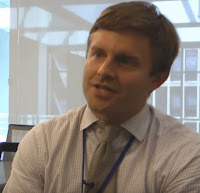I found this inspiring piece on the
KDUK website
this morning. Helen Devine found a way to help explain Kennedy’s Disease and
the current research associated with this rare disorder.
When Research Meets Poetry
We have seen at first hand now passionate and driven the
research team at UCL is. What we didn’t Helen is at the front line in the fight
against Kennedy's Disease, and to further raise awareness, she entered this poem
in a Medical Research Council competition that sought creative writing from
researchers that told readers '"Why does my research matter?' We at Kennedy's
Disease UK were delighted that Helen was one of the 14 shortlisted finalists
this year. Sadly, she didn’t win, but we feel she's a winner with this great
explanation of Kennedy's Disease and the vital research she and the team are
carrying out at University College London (UCL).
The Max Perutz Science Writing Award aims to encourage and recognize
outstanding written communication among MRC PhD students. The annual
competition challenges entrants to write an 800-word article for the general
public answering tine question: 'Why does my research matter? This is Helen's
fantastic entry.
An Ode to the
Androgen Receptor
Neurodegenerative
diseases
Occur when
nerve cells die
We certainly
know that it happens
But we
aren't quite sure how or why
Parkinson's
Disease would be easy
And Alzheimer’s
or Huntington’s too
They're probably
near the top of your list
If I asked
you to name me a few.
But Spinal
Bulbar Muscular Atrophy?
Not heard of
it before?
There's
something special about it,
Let me tell
you a little bit more.
Weakness in
the arms and legs
Make it
tricky for patients to walk
Weakness in
the face and tongue
Make it hard
to swallow and to talk.
The faults
in the Androgen Receptor
A particular
genetic mutation
Male
patients have the disease
Women pass
it to the next generation.
When the
receptor binds testosterone
The troubles
really start
Patients get
weakness, infertility
And problems
in the heart_
The disease
is slowly progressive
With no
treatment and no cure
I'm hoping
that might change
If I can
understand it a little bit more.
So I'm going
on a journey
To find out
why these cells die
I am
searching for the pathways
using
microscopes and dyes.
The very
first step is to find a way
To make a
good human model
Studies from
other cells and mice
May not snow
the real disease problem.
Induced
pluripotent stem cells
Are an
exciting new innovation
Stem cells
from patient skin cells
Have the
androgen receptor mutation.
Motor nerves
from stem cells
I grow them
up in a dish
And once
they are fully grown
I can study them
with relish_
Stress,
transport, mitochondria
Possible
avenues to pursue
In the
course of the research
I may find
something new.
Stress is hard to deal with
In research
and in a cell
I can go for
a little jog
But a cell
can't in a well.
So they have
a special mechanism
The neat
shock response its name
If this
isn't working correctly
Then it may
be to blame.
Axons carry
the messages
One end of
the cell to the other
A traffic
jam in this transport
Can lead to a
spot of bother,
Motor nerves
are very long
So they are
at great risk
If blockages
and hold ups
Mean
transport isn't brisk.
Mitochondria
provide the energy
A cell needs
to survive
If the fuel
supply isn't good enough
Then the
cell can start to die.
So if their
shape is faulty
And they
aren't working right
Tine cells
start to malfunction
Pack up and
say goodnight
If cell
death is like a puncture
Discovering
it is not enough
The next job
is to fix it
And that can
prove quite tough.
Motor neurons
on a plate
Will be a
way to screen
For a drug
to reverse cell death;
That would
De the dream.
SBMA is a
rare disease
But patients
still need a cure
I hope I can
identify a good one
That's what
my research is for.
The findings
that I find
May also
hold the key
To overall
common pathways
In
neurodegenerative disease.
My research
is for patients with SBMA
For whom
taking journeys is hard
And for whom
it is a challenge
To read this
poem out loud.








